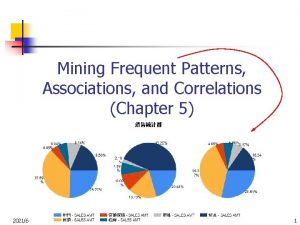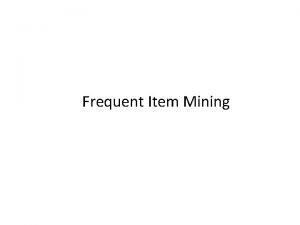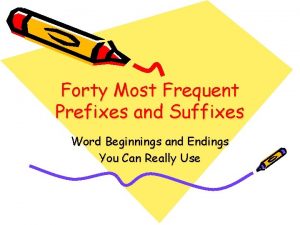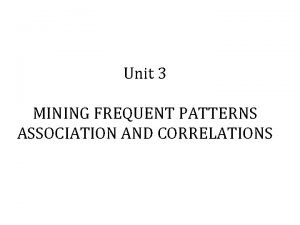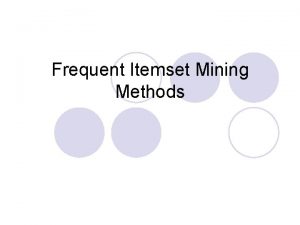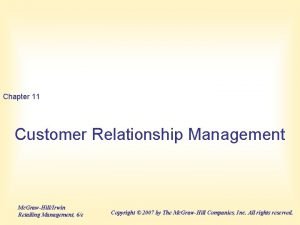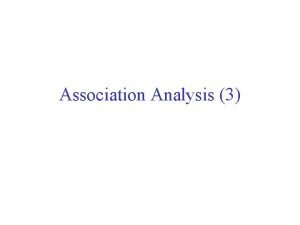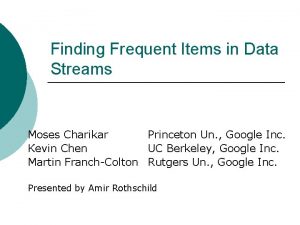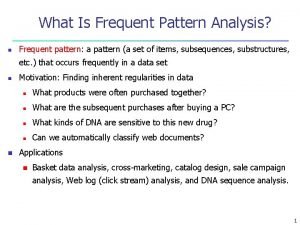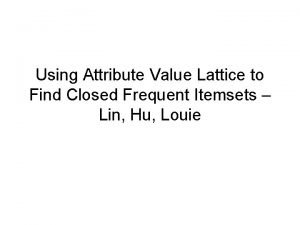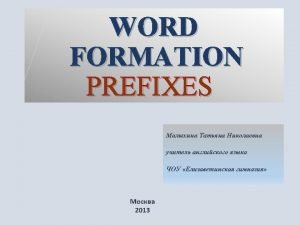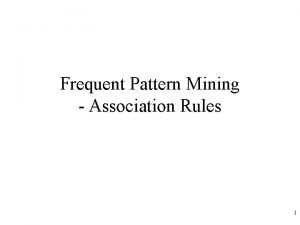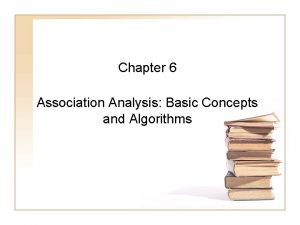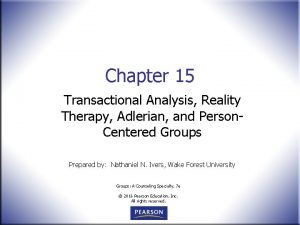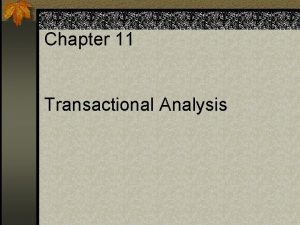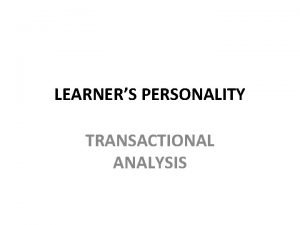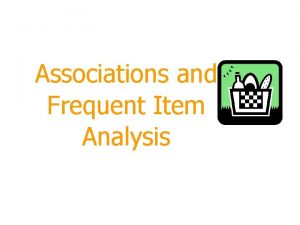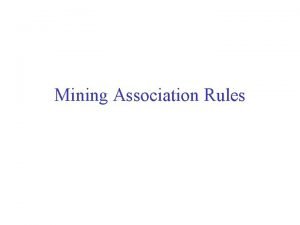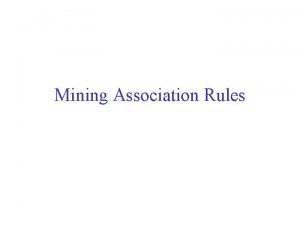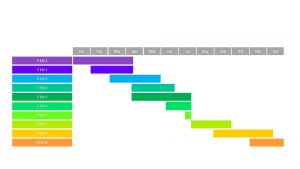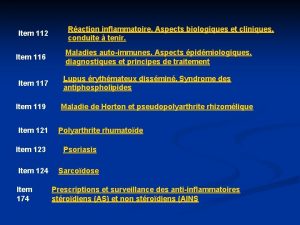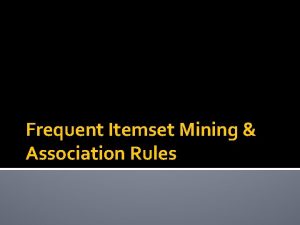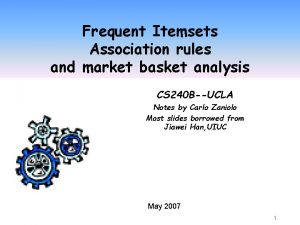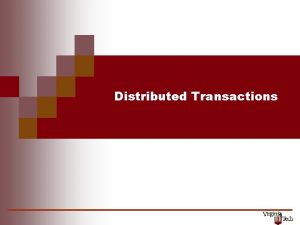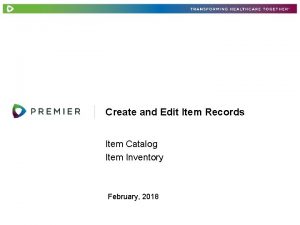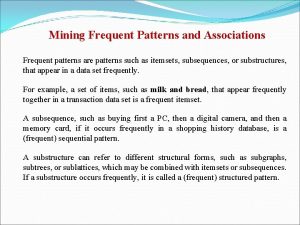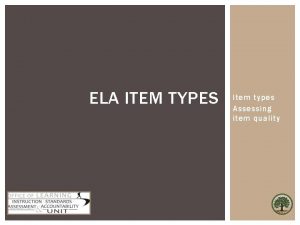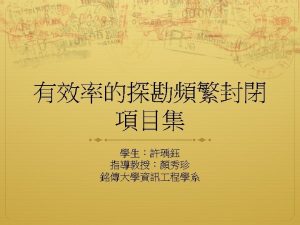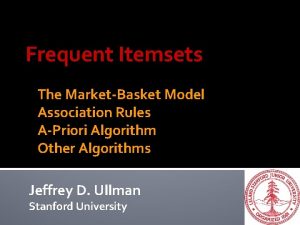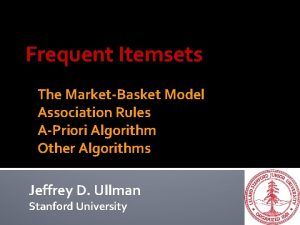Association Rules and Frequent Item Analysis Outline Transactions






























- Slides: 30

Association Rules and Frequent Item Analysis

Outline § Transactions § Frequent itemsets § Subset Property § Association rules § Applications 2

Transactions Example 3

Transaction database: Example, 1 Instances = Transactions ITEMS: A = milk B= bread C= cereal D= sugar E= eggs 4

Transaction database: Example, 2 Attributes converted to binary flags 5

Definitions § Item: attribute=value pair or simply value § usually attributes are converted to binary flags for each value, e. g. product=“A” is written as “A” § Itemset I : a subset of possible items § Example: I = {A, B, E} (order unimportant) § Transaction: (TID, itemset) § TID is transaction ID 6

Support and Frequent Itemsets § Support of an itemset § sup(I ) = no. of transactions t that support (i. e. contain) I § In example database: § sup ({A, B, E}) = 2, sup ({B, C}) = 4 § Frequent itemset I is one with at least the minimum support count § sup(I ) >= minsup 7

SUBSET PROPERTY § Every subset of a frequent set is frequent! § Q: Why is it so? § A: Example: Suppose {A, B} is frequent. Since each occurrence of A, B includes both A and B, then both A and B must also be frequent § Similar argument for larger itemsets § Almost all association rule algorithms are based on this subset property 8

Association Rules § Association rule R : Itemset 1 => Itemset 2 § Itemset 1, 2 are disjoint and Itemset 2 is non-empty § meaning: if transaction includes Itemset 1 then it also has Itemset 2 § Examples § A, B => E, C § A => B, C 9

From Frequent Itemsets to Association Rules § Q: Given frequent set {A, B, E}, what are possible association rules? § A => B, E § A, B => E § A, E => B § B => A, E § B, E => A § E => A, B § __ => A, B, E (empty rule), or true => A, B, E 10

Classification vs Association Rules Classification Rules Association Rules § Focus on one target field § Many target fields § Specify class in all cases § Applicable in some cases § Measures: Accuracy § Measures: Support, Confidence, Lift 11

Rule Support and Confidence § Suppose R : I => J is an association rule § sup (R) = sup (I J) is the support count § support of itemset I J (I or J) § conf (R) = sup(J) / sup(R) is the confidence of R § fraction of transactions with I J that have J § Association rules with minimum support and count are sometimes called “strong” rules 12

Association Rules Example, 1 § Q: Given frequent set {A, B, E}, what association rules have minsup = 2 and minconf= 50% ? A, B => E : conf=2/4 = 50% 13

Association Rules Example, 2 § Q: Given frequent set {A, B, E}, what association rules have minsup = 2 and minconf= 50% ? A, B => E : conf=2/4 = 50% A, E => B : conf=2/2 = 100% B, E => A : conf=2/2 = 100% E => A, B : conf=2/2 = 100% Don’t qualify A =>B, E : conf=2/6 =33%< 50% B => A, E : conf=2/7 = 28% < 50% __ => A, B, E : conf: 2/9 = 22% < 50% 14

Find Strong Association Rules § A rule has the parameters minsup and minconf: § sup(R) >= minsup and conf (R) >= minconf § Problem: § Find all association rules with given minsup and minconf § First, find all frequent itemsets 15

Finding Frequent Itemsets § Start by finding one-item sets (easy) § Q: How? § A: Simply count the frequencies of all items 16

Finding itemsets: next level § Apriori algorithm (Agrawal & Srikant) § Idea: use one-item sets to generate two-item sets, two-item sets to generate three-item sets, … § If (A B) is a frequent item set, then (A) and (B) have to be frequent item sets as well! § In general: if X is frequent k-item set, then all (k-1)item subsets of X are also frequent Compute k-item set by merging (k-1)-item sets 17

Another example § Given: five three-item sets (A B C), (A B D), (A C E), (B C D) § Lexicographic order improves efficiency § Candidate four-item sets: (A B C D) Q: OK? A: yes, because all 3 -item subsets are frequent (A C D E) Q: OK? A: No, because (C D E) is not frequent 18

Generating Association Rules § Two stage process: § Determine frequent itemsets e. g. with the Apriori algorithm. § For each frequent item set I § for each subset J of I § determine all association rules of the form: I-J => J § Main idea used in both stages : subset property 19

Example: Generating Rules from an Itemset § Frequent itemset from golf data: Humidity = Normal, Windy = False, Play = Yes (4) § Seven potential rules: If Humidity = Normal and Windy = False then Play = Yes 4/4 If Humidity = Normal and Play = Yes then Windy = False 4/6 If Windy = False and Play = Yes then Humidity = Normal 4/6 If Humidity = Normal then Windy = False and Play = Yes 4/7 If Windy = False then Humidity = Normal and Play = Yes 4/8 If Play = Yes then Humidity = Normal and Windy = False 4/9 If True then Humidity = Normal and Windy = False and Play = Yes 4/12 20

Rules for the weather data § Rules with support > 1 and confidence = 100%: Association rule Sup. Conf. 1 Humidity=Normal Windy=False Play=Yes 4 100% 2 Temperature=Cool Humidity=Normal 4 100% 3 Outlook=Overcast Play=Yes 4 100% 4 Temperature=Cold Play=Yes Humidity=Normal 3 100% . . . . 58 Outlook=Sunny Temperature=Hot Humidity=High 2 100% § In total: 3 rules with support four, 5 with support three, and 50 with support two 21

Weka associations File: weather. nominal. arff Min. Support: 0. 2 22

Weka associations: output 23

Filtering Association Rules § Problem: any large dataset can lead to very large number of association rules, even with reasonable Min Confidence and Support § Confidence by itself is not sufficient § e. g. if all transactions include Z, then § any rule I => Z will have confidence 100%. § Other measures to filter rules 24

Association Rule LIFT § The lift of an association rule I => J is defined as: § lift = P(J|I) / P(J) § Note, P(I) = (support of I) / (no. of transactions) § ratio of confidence to expected confidence § Interpretation: § if lift > 1, then I and J are positively correlated lift < 1, then I are J are negatively correlated. lift = 1, then I and J are independent. 25

Other issues § ARFF format very inefficient for typical market basket data § Attributes represent items in a basket and most items are usually missing § Interestingness of associations § find unusual associations: Milk usually goes with bread, but soy milk does not. 26

Beyond Binary Data § Hierarchies § drink milk low-fat milk Stop&Shop low-fat milk … § find associations on any level § Sequences over time §… 27

Applications § Market basket analysis § Store layout, client offers § Finding unusual events § WSARE – What is Strange About Recent Events § … 28

Application Difficulties § Wal-Mart knows that customers who buy Barbie dolls have a 60% likelihood of buying one of three types of candy bars. § What does Wal-Mart do with information like that? 'I don't have a clue, ' says Wal-Mart's chief of merchandising, Lee Scott § See - KDnuggets 98: 01 for many ideas www. kdnuggets. com/news/98/n 01. html § Diapers and beer urban legend 29

Summary § Frequent itemsets § Association rules § Subset property § Apriori algorithm § Application difficulties 30
 Metaphor adalah
Metaphor adalah Kelvin rodolfo
Kelvin rodolfo International business transactions outline
International business transactions outline Penyebab benign neoplasm of breast d24
Penyebab benign neoplasm of breast d24 Mining frequent patterns associations and correlations
Mining frequent patterns associations and correlations Frequent pattern
Frequent pattern Eclat algorithm
Eclat algorithm Maximal and closed frequent itemsets
Maximal and closed frequent itemsets 100 prefix words
100 prefix words Mining frequent patterns associations and correlations
Mining frequent patterns associations and correlations Quote sandwich
Quote sandwich Frequent itemset mining methods
Frequent itemset mining methods Customer relationship management in retailing
Customer relationship management in retailing Alternative methods for generating frequent itemsets
Alternative methods for generating frequent itemsets Frequent earthquakes in an area may indicate *
Frequent earthquakes in an area may indicate * Dbminer
Dbminer Mining frequent patterns without candidate generation
Mining frequent patterns without candidate generation Finding frequent items in data streams
Finding frequent items in data streams Closed pattern and max pattern
Closed pattern and max pattern Closed frequent pattern
Closed frequent pattern Tornadoes are most frequent from _____.
Tornadoes are most frequent from _____. Literate negative form
Literate negative form Closed frequent pattern
Closed frequent pattern Operation frequent wind
Operation frequent wind Laag frequent geluid
Laag frequent geluid L
L Association analysis advanced concepts
Association analysis advanced concepts The most common form of hair removal in salons and spas is:
The most common form of hair removal in salons and spas is: Types of transactions in transactional analysis
Types of transactions in transactional analysis Time structuring in transactional analysis
Time structuring in transactional analysis Ulterior transactions in transactional analysis
Ulterior transactions in transactional analysis




